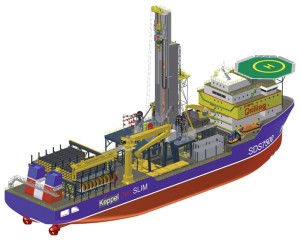Slim drillship conceptualized for optimized subsea intervention

Working with Stena Drilling, Keppel Offshore & Marine has proposed a slim drillship design optimized for re-entry into existing subsea wells. The design was detailed by Dr Asbjorn Mortensen, Keppel O&M, during a presentation at the 2010 IADC/SPE Asia Pacific Drilling Technology Conference, 1-3 November in Ho Chi Minh City, Vietnam.
Driven by the increasing number of subsea wells and the need to maintain those wells, the new drillship design was conceptualized to perform intervention operations using wireline and coiled tubing equipment through a high-pressure riser string between the ship and the subsea wellhead, Dr Mortensen said. The drillship is also equipped to drill new hole sections inside existing wells, such as long horizontal extensions, using slim jointed pipe that enters the well inside its production tubing.
A key feature of the slim drillship is its high-pressure riser, which gives intervention tools access to the well and eliminates the need to kill the well first with drilling mud. This feature enables the vessel to use managed pressure drilling (MPD) methods.
The drillship is initially designed to operate in up to 7,500 ft of water and to drill up to 22,500 ft deep. It has a drilling mast rather than an enclosed derrick in order to provide easy access to the well center for intervention equipment from the extended drill floor and from the poop deck. In order to be able to pass the Panama Canal, the telescopic mast was made to be less than 58 m high, Dr Mortensen added.
Because the drillship was envisioned to be a smaller – and therefore cheaper – vessel, it was designed to an overall length of 145 m and breadth of 30.2 m. It is larger than pure subsea construction vessels and pure intervention vessels carrying riser joints 7 in. to 11 in. ID. It also differs with its ability to drill new well sections by joined drill pipe TTRD and MPD and use high-pressure risers with up to 14-in. ID.
There is a large deck area near the drillfloor to provide open space for storage of third-party equipment and tubulars. The drillfloor itself also provides the maximum area for intervention equipment, as well as direct access to the well center line for the coil from coiled tubing skids and for the wire from wireline skids.
The design also features an extended recessed moonpool to allow a BOP trolley with a forklift feeding high BOP components under the drillfloor
Among the new technologies employed on the drillship is a shaker system developed by a company called Cubility. The system uses a vacuum technology and a rotating screen to separate the cuttings from the mud. The vacuum type shaker is advantageous for the size of the slim drillship because it reduces the size of the ventilation system in the shaker room. The settling tanks are reduced in volume as well.
Dr Mortensen noted that the new shaker technology is being tested on two fields in the North Sea by Statoil.
More information about this slim drillship design can be found in IADC/SPE 136669, “A Conceptual Development of a Slim Drill Ship.”




